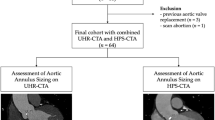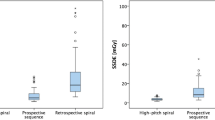Abstract
Determination of the coplanar view is a critical component of transcatheter aortic valve replacement (TAVR). The safety and accuracy of a novel reduced angular range C-arm computed tomography (CACT) approach coupled with a fully automated 3D analysis tool package to predict the coplanar view in TAVR was evaluated. Fifty-seven patients with severe symptomatic aortic stenosis deemed prohibitive-risk for surgery and who underwent TAVR were enrolled. Patients were randomized 2:1 to CACT vs. angiography (control) in estimating the coplanar view. These approaches to determine the coplanar view were compared quantitatively. Radiation doses needed to determine the coplanar view were recorded for both the CACT and control patients. Use of CACT offered good agreement with the actual angiographic view utilized during TAVR in 34 out of 41 cases in which a CACT scan was performed (83 %). For these 34 cases, the mean angular magnitude difference, taking into account both oblique and cranial/caudal angulation, was 1.3° ± 0.4°, while the maximum difference was 7.3°. There were no significant differences in the mean total radiation dose delivered to patients between the CACT and control groups as measured by either dose area product (207.8 ± 15.2 Gy cm2 vs. 186.1 ± 25.3 Gy cm2, P = 0.47) or air kerma (1287.6 ± 117.7 mGy vs. 1098.9 ± 143.8 mGy, P = 0.32). Use of reduced-angular range CACT coupled with fully automated 3D analysis tools is a safe, practical, and feasible method by which to determine the optimal angiographic deployment view for guiding TAVR procedures.



Similar content being viewed by others
References
Leon MB, Smith CR, Mack M et al (2010) Transcatheter aortic-valve implantation for aortic stenosis in patients who cannot undergo surgery. New Engl J Med 363:1597–1607
Smith CR, Leon MB, Mack MJ et al (2011) Transcatheter versus surgical aortic-valve replacement in high-risk patients. New Engl J Med 364:2187–2198
Gurvitch R, Wood DA, Leipsic J et al (2010) Multislice computed tomography for prediction of optimal angiographic deployment projections during transcatheter aortic valve implantation. J Am Coll Cardiol Cardiovasc Interv 3:1157–1165
Kasel AM, Cassese S, Leber AW, von Scheidt W, Kastrati A (2013) Fluoroscopy guided aortic root imaging for TAVR: “follow the right cusp” rule. J Am Coll Cardiol Cardiovasc Imaging 6:274–275
Kim MS, Bracken J, Nijhof N et al (2014) Integrated 3D Echo-X-Ray navigation to predict optimal angiographic deployment projections for TAVR. J Am Coll Cardiol Cardiovasc Imaging 7:847–848
Tzikas A, Schultz C, Van Mieghem NM, de Jaegere PP, Serruys PW (2010) Optimal projection estimation for transcatheter aortic valve implantation based on contrast-aortography. Catheter Cardiovasc Interv 76:602–607
Schwartz JG, Neubauer AM, Fagan TE, Noordhoek NJ, Grass M, Carroll JD (2011) Potential role of three-dimensional rotational angiography and C-arm CT for valvular repair and implantation. Int J Cardiovas Imaging 27:1205–1222
Azzalini L, Sharma UC, Ghoshhajra BB et al (2014) Feasibility of C-arm computed tomography for transcatheter aortic valve replacement planning. J Cardiovasc Comput Tomogr 8:33–43
Binder RK, Leipsic J, Wood D et al (2012) Prediction of optimal deployment projection for transcatheter aortic valve replacement: angiographic 3-dimensional reconstruction of the aortic root versus multidetector computed tomography. Circ Cardiovasc Interv 5:247–252
Bland JM, Altman DG (1986) Statistical methods for assessing agreement between two methods of clinical measurement. Lancet 1:307–310
Cohen J, Cohen P, West SG, Aiken LS (2013) Applied multiple regression/correlation analysis for the behavioral sciences. Routledge, New York
Zheng Y, John M, Liao R et al (2012) Automatic aorta segmentation and valve landmark detection in C-arm CT for transcatheter aortic valve implantation. IEEE Trans Med Imaging 31:2307–2321
Acknowledgments
This work was supported with funding from Philips Healthcare.
Author information
Authors and Affiliations
Corresponding author
Ethics declarations
Conflict of interest
John Carroll, MD is a consultant, receives research support, and through the University of Colorado receives royalties (for intellectual property not related to this manuscript) from Philips Healthcare. Michael Kim, MD receives research support from Philips Healthcare. John Bracken, PhD and Peter Eshuis, PhD are employees of Philips Healthcare.
Rights and permissions
About this article
Cite this article
Kim, M.S., Bracken, J., Eshuis, P. et al. Use of short roll C-arm computed tomography and fully automated 3D analysis tools to guide transcatheter aortic valve replacement. Int J Cardiovasc Imaging 32, 1145–1152 (2016). https://doi.org/10.1007/s10554-016-0886-0
Received:
Accepted:
Published:
Issue Date:
DOI: https://doi.org/10.1007/s10554-016-0886-0




